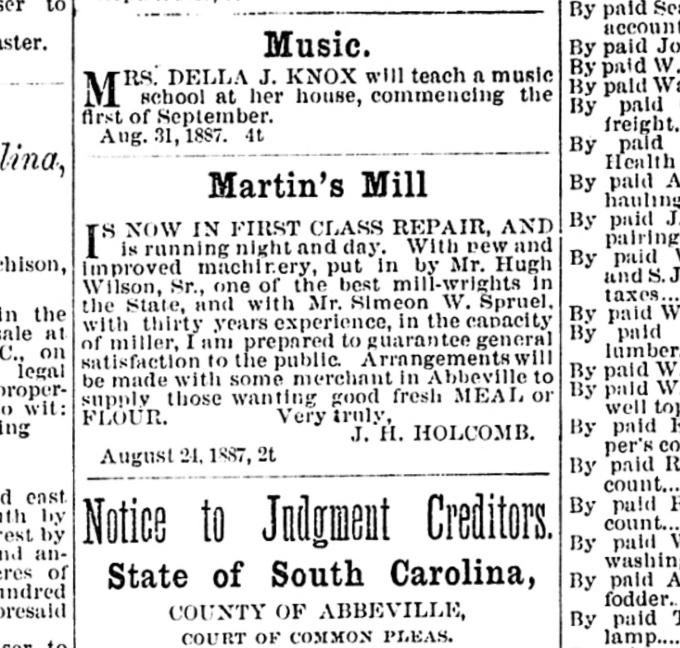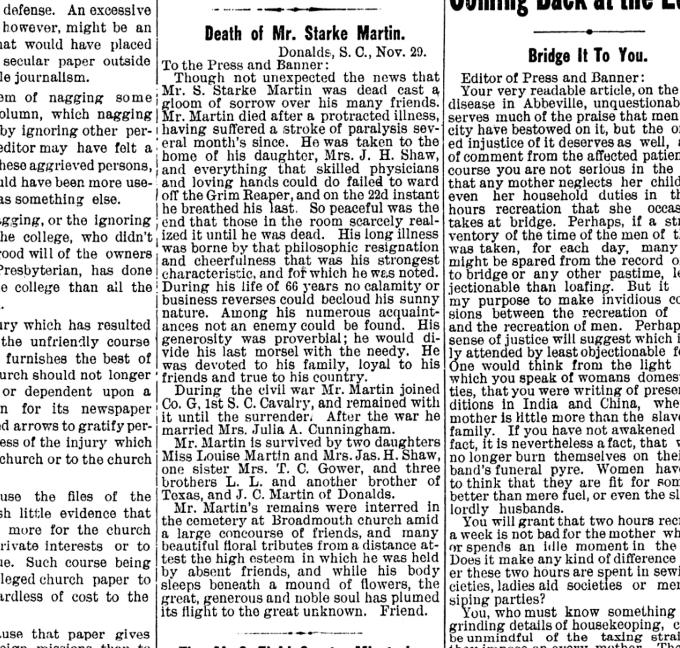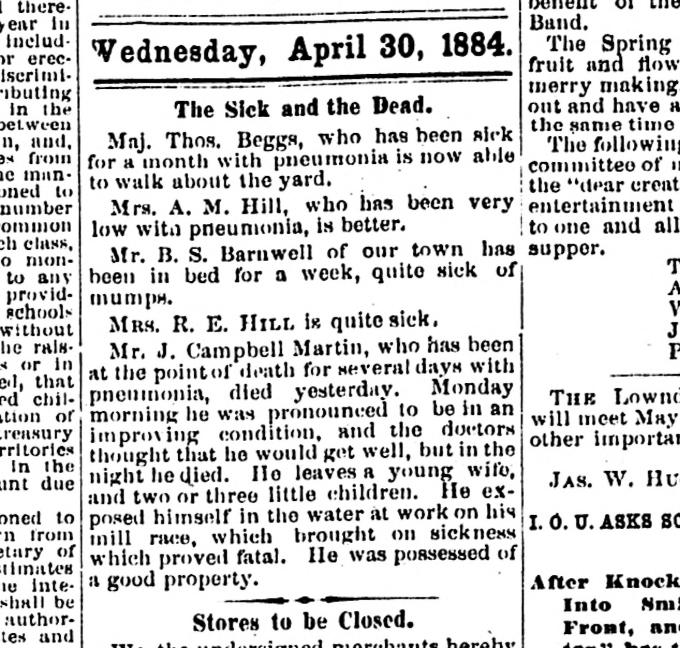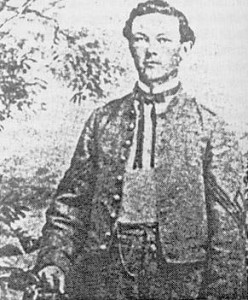Interesting Data On Monterrey, Old Abbeville Community, Recalled
Br DR. A. J. SPEER
ABBEVILLE—It is interesting to study a map of the United States and note the names of communities, towns and cities, some names in time being completely forgotten, or the communities renamed, while others grow into great metropolitan centers alive with industry, and commerce, making America a great nation at home and abroad among the nations of the world.
It is also interesting to study further the history of a particular community on this map and note how it got its name and who were the people who first settled the territory and began developing a way of life that is indigenous to America.
Monterey in the western part of Abbeville County, long forgotten by many people, happens to be one of these communities along with many others in the Savannah River Valley.
The builders of the railroads and the glamorous escapades of the Iron Horse did more to change this map in the early days perhaps than any other known factor in our national life, before the coming of the automobile and the airplane.
The outside contacts of the settlements were limited to walking distances, in the day of the horse and the individual settler.
A recent study of the Post Office Department Archives, Washington D.C. reveals some very interesting data about old Monterey. This community was earlier called Bull Town, in honor of Governor Bull of Charleston who made a satisfactory treaty with the Cherokee Indians that brought peace to the settlers of the up country.
The records show that the first post office at the Monterey site was established May 6, 1847 in District Ninety Six and that William Andrew Giles was appointed first postmaster. He is buried along with many others of this community in the family plot of old Rocky River church graveyard which was moved from Bull Town Fort in Monterey on lands now owned by J. T. Clinkscales, and given the new name of Rocky River Presbyterian church. The old cemetery is all that remains of this historic church site.
Mexican War Gave Name
During this period the United States was at war with Mexico in which South Carolina was more interested than any other state due to the fact, no doubt, that South Carolina had more troops participating in the war than any other state in the Union.
Tradition tells us that the Post Office Department in Washington gave the first postmaster the privilege of naming the post office. At about this time the news of the battle of Monterey was received and the part that South Carolina troops played in the capture of that Mexican stronghold was given wide publicity, especially in South Carolina. Later, history tells us that they were among the first troops to climb over the walls of the Mexican city and hoist the flag, which was a South Carolina state flag, carried by Frederick W. Selleck, a native of Abbeville.
So William Andrew Giles, the first postmaster, sent in the name “Monterey” as a tribute to the South Carolina [t]roops who participated in the Mexican War and Washington approved the name of “Monterey” and made it a matter of record.
The archives in Washington reveal that the mail route started in Abbeville, stopping at the following points:
- Temple of Health (later discontinued)
- Warrenton (seven miles from Abbeville)
- Church Hill (this location was evidently between Monterey and Lowndesville.)
- Cherokee Heights, site of the Block House in the Fork where Rocky River runs into the Savannah River.)
- Harper’s Ferry, (on Savannah River)
- Ruckersville, Georgia
- To Elberton Georgia, and return to Abbeville, a distance of 46 miles.
Mail delivery was to be twice per week, and T. P. Morley was the contractor., the custom being for contractors to bid in the mail routes and sublet them to the carriers.
When Charleston and Western Carolina railroad was built in 1885-6 and the Georgia, Carolina, and Northern railroad, later known as the Seaboard in 1890-3, the mail delivery system was changed radically in many communities. The Abbeville-Elberton route was discontinued and Monterey was served direct, three times a week, from Latimer, a station on the Charleston and Western Carolina Railroad. Later the R.F.D. supplanted the Latimer-to-Monterey service with daily mail out of Abbeville, now operated by Mr. Ashley, and is equal to a city delivery in point of service.
The original Monterey post office moved from time to time as changes in post master took place and families moved away or the elder ones died, but it never was moved more than a mile or a mile and a half from the original location in the country store of William Andrew Giles. Merchandise from this store was hauled from Charleston on wagons over the old Charleston road, traces of this old road can still be pointed out although covered with trees and undergrowth.
The original store and home building still stands and is now owned and occupied by Charles Grantham.
The after-effects of the Mexican war not only made its impress on the nation as a whole, particularly the South and East, but it also made a deep impression on the Monterey community.
Annual Muster Big Event
McCaw’s Old Field, located on lands now owned by Mr. Patterson of Calhoun Falls, became the “muster” ground for a wide area in the Abbeville District. Once a year the annual “muster” was held on this field, attended by dignitaries, statesmen and politicians of no mean rank, along with the civicial colonels, captains, Lieutenants and young men of the line —all to take part in the grand review of the military strength of this part of upper South Carolina. The patriotic spirit and enthusiasm that swept South Carolina at that time can best be understood by the incident of a high-ranking officer who was on an extended visit to Alabama. His rank as a civilian military officer placed him next in command for the annual muster at McCaw’s Old Field. The message notifying him of the “muster” was late in delivery. This was disconcerting as he had planned to attend to show his loyalty and patriotism. The message also stated that the senior ranking officer would not be able to attend and full command of the annual muster would fall on his shoulders. This was an honor of a life time, so he swung into his saddle at once and rode night and day from Alabama to McCaw’s Old Field arriving just in time to take full command of the annual muster. He would not have missed this grand parade in the presence of all the ladies and dignitaries for any amount of money.
This spirit of patriotic enthusiasm following the Mexican War grew all over the South, culminating in the upheaval of 1860. My father, George W. Speer, along with many others enlisted at McCaw’s Old Field, starting on the long road to Fort Sumter, Gettysburg and Appomattox, with so many who did not come back.
Beef Market Co-Op
In this modern day we have advanced a long way in the field of co-operatives, and the end is not yet in sight. This idea, born of necessity, stems back to the early days from the co-op principle is not a modern invention.
Monterey had a cooperative long before Washington authorized the name “Monterey.” There was neither ice nor deep freezes, but the people of Monterey had fresh tender cuts of beef early each Saturday throughout the summer months. During the winter months the weather preserved the meat supply with the assistance of the householder, but the summer months created a problem. To meet the situation a Beef Club, or “Beef Market” as it was called was organized and “Understandings,” not rules, governed its operation. A fat half-grown cow weighing about 250 pounds was slaughtered early Saturday by a member of the club. The carcass was cut up into equal parts by weight, with names familiar to all, such as pound, loin, brisket, neck, etc. The latter, being the most undesirable cut of all, led to the trite saying of “neck or no beef,” which in modern parlance would be better understood by the expression, “Take it or leave it.” However, when the summer season was over each family had consumed one or two whole carcasses, including all the choice cuts along with the undesirable ones. My earliest recollection of this co-op was watching the riders from each neighbor, singly or in groups with white, clean salt sacks resting in the pommels of the saddles “going after beef.”
Tradition tells us that this early Monterey co-op ran continuously for 72 years without a break, with the exception of one year during the Civil War when things were so disorganized it did not seem feasible to operate the club.
The Church and The School
The two outstanding factors that contributed more to this community than anything else at this period, were the Old Rocky River Presbyterian Church and the Monterey school. Those who served as pastors of this church were well educated ministers whose language, manners and philosophies of life set the example for the people to follow. Crowding into our memories are such names as McBride, Nicholson, Fennel, Wilson, Lindsay, Link, McLin and others who left a lasting impression on both old and young in old Monterey.
Of this group of ministers, one became the resident pastor, living in the community, preaching regularly on Sundays and teaching during the weekdays in the early Monterey school. He was Rev. H. C. Fennel. There were two types of elders in the early church: the ruling elder and the teaching elder. Mr. Fennel moved up a degree adding dignity and understanding to the ministerial profession by becoming a teaching preacher. He was a great and good man. After a close study of the minutes of the church covering the period from 1876 when he first came to the church as a supply, to 1913 a period of 35 years, the name of the Rev. H. C. Fennel stands out above all others. The records show gaps and some intermissions while he served other churches, but he would always come back to old Monterey.
The same of Mr. Fennel’s school spread far and wide and students, some of adult age, rode horseback, from a distance or boarded in the neighborhood in order to attend. A transition in the schools of America at this period was taking place. The old-time athletic type schoolmaster with a keen hickory switch in evidence at all times, who taught all day when he was not whipping, was fading out of the picture. Mr. Fennel created the “thirst for knowledge” in the minds of the students and his school prospered. Consciously or unconsciously he laid the foundation for research in educational systems and the “know how” in American Industry.
In addition to being an educator, as well a minister, he was an inventor. My earliest recollection and keen interest in things mechanical, were aroused by his two “inventions.” One was an evaperator (sp) that was placed on top of a stove to dry fruit rapidly. The other was an attachment for quickly releasing a runaway horse, from a buggy by the driver, thus preventing injury to the occupant of the vehicle. We do not know how many of his numerous other ideas were never fully developed or ever recorded.
Sough to Enlarge School
The following incident does not appear in the records, but it is a fact nonetheless. At the height of the popularity of the Monterey school, Mr. Fennel enlisted the neighborhood in a program of making the school larger with the objective of becoming a “feeder” for Davidson, the recognized church college. The records of the church from its very inception show contributions paid to the Presbytery for education. They were small but definitely this was a part of the church program. Probably this was the reason for Mr. Fennel’s zeal for the school, believing that Presbytery had a large fund at headquarters for this purpose.
The neighborhood was set to work cutting fine oak and pine timber for the construction of the main building. A site was selected and land donated by Edward Calhoun fronting the mail road. A more beautiful spot could not have been selected for a school. Large white oak trees ingled (sp) with cedars covered the grounds, which sloped naturally towards the highway. The timber was cut, hewn and stacked on the ground, the proposition was then presented to the Presbytery for funds to launch the “feeder” for Davidson, and was turned down cold. Thus the institution died aborning. However, no one could say that the Rev. H. C. Fennel did not try.
The Monterey post office served a useful purpose, in maintaining a contact with the outside world. In the early days the local post office recorded names and handled mail. Sealing wax instead of envelopes was used and postage was twenty five cents a letter. It was the gathering place for the community. Exchange of ideas, information and mutual aid was the order of the day.
Monterey was no different than thousands of other communities in America in all its activities, except when it came to the names of the people who once lived there, and their descendants bearing the same name, start a flood of memories– then to them it is different. Such names as: Giles, Baskin, Tilman, Cater, Clinkscales, Haskell, Poore, Lanier, Calhoun, Fennel, Gilbert, Speer, Power, Cunningham, Waters, Burris, Bell, Spouse, Nance, Roverson, Wilson, Patterson, Price, Grantham, and many others who once lived or still maintain contact with this community will look back to the days of Monterey as a starting point for them in making America, and all that she stands for, not only strong but safe.
The Index-Journal
Greenwood, South Carolina •
Thu, May 22, 1952
Page 3









